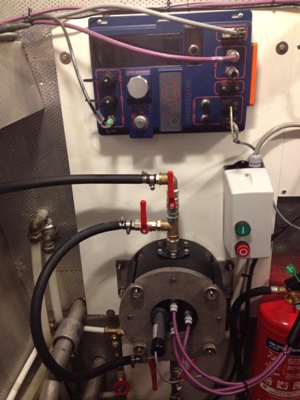Xylem Analytics UK and Aanderaa Data Instruments have launched a new marine water quality monitor which has been designed to enable wider deployment of water quality sensors on ferries and other marine vessels.
 SOOGuard FerryBox
SOOGuard FerryBox
The ‘SOOGuard’ will be launched at Ocean Business 2013 in April and Xylem’s David Goldsmith says: “In order to encourage the operators of ferries to allow the installation of monitoring equipment on their vessels, it is vitally important that the instrumentation is easy to maintain and reliable.
“Traditional FerryBoxes are expensive bespoke systems, but by combining considerable design experience with the latest sensor and datalogging technology, the SOOGuard offers improved performance at a substantially lower cost.”
Background
Ferries, container ships and other vessels continuously traverse ocean and coastal environments in repeated journeys that offer an excellent opportunity to generate high quality information on surface water quality. This data is extremelyvaluable for the management and protection of the oceans; for informing global meteorology and climate change research; for calibrating satellite imagery, and for the management of fisheries.
In recent years, marine scientists have installed continuous monitoring systems on ‘ships of opportunity’ to routinely collect spatial and temporal oceanographic data. These instruments are known as ‘FerryBoxes’ and monitor the quality of water that is pumped from a subsurface inlet – often the engine cooling water supply.
TheFerryBoxconcept is now recognised worldwidefor its potential to provide much needed data, cost-effectively. FerryBoxeshavenow been installed in many countries includingAustralia, Chile,Japan and the USA. In Europe projects such as EMECO (European Marine Ecosystem Observatory) and COSYNA (Coastal Observation System for Northern and Arctic Seas) are utilising the technology to deliverdata to a wide user community.
The SOOGuard FerryBox – what’s new
In the past, FerryBoxes have been custom-built and as a result, some of the older systems are complex and difficult to service or maintain. A key objective for the SOOGuard design team was therefore to develop a FerryBox that would meet the needs of most vessels whilst requiring the minimum of operational support.
The system’s four sensors (conductivity, temperature, optical dissolved oxygen and chlorophyll a) are fitted onto the door of a flow-through cell - a design that allows simple and rapid cleaning.The sensors are very stable and require calibration checksless than once a year in most environments. Further flow-though cells can be fitted to allow for the measurement of additional parameters.
The National Oceanography Centre, Southampton (NOC) has worked with FerryBoxes since 1999 and their staff helped design the SOOGuard. The NOC’s David Hydes says: “Our experience has shown that these systems need to be simple to operate and must avoid issues such as air bubbles, biofouling and sedimentation. The compact robust design of the Aanderaa Smart Sensorssuits a system that is easily maintained by a ship’s crew and can be easily fitted to almost any ship or boat.The deployment of sensors in a small flow-through chamber means that installation is simpler and fouling is reduced.”
A SOOGuard system has been fitted to the NOC’s 20 metre coastal research catamaran, the RV Callista, and Gary Fisher, who manages Southampton University’s vessels, says “The system has been very straight forward to operate; we have a computer on-board displaying real-time results and these are also stored in the system’s datalogger. We have not experienced any significant sedimentation, so we are very pleased with the design.”
The system is complemented by a hull temperature sensor to support the chamber measurements, and a flow sensor provides confirmation that the system has a continuous feed of water.
While readings are stored locally in the system’s datalogger, communication via GSM, GPRS and Iridium satellite is also possible. Additionally, users can access transmitted data via a web-based interface.
Summarising, David Goldsmith says: “Only a few ships are fitted with FerryBoxesat the moment, and these are run by specialist groups. We believe that the SOOGuard will enable that number to grow substantially and provide data reliably to a much wider community of marine and aquatic scientists because of its low cost, small size, easy installation and low requirement forroutine support.”
Visitors to Ocean Business 2013 (9-11 April) will be able to see a SOOGuard on the Xylem Analytics stand (H2-4) where live data from the system installed on RV Callista will be streamed.
Further information is available at www.xylemanalytics.co.uk